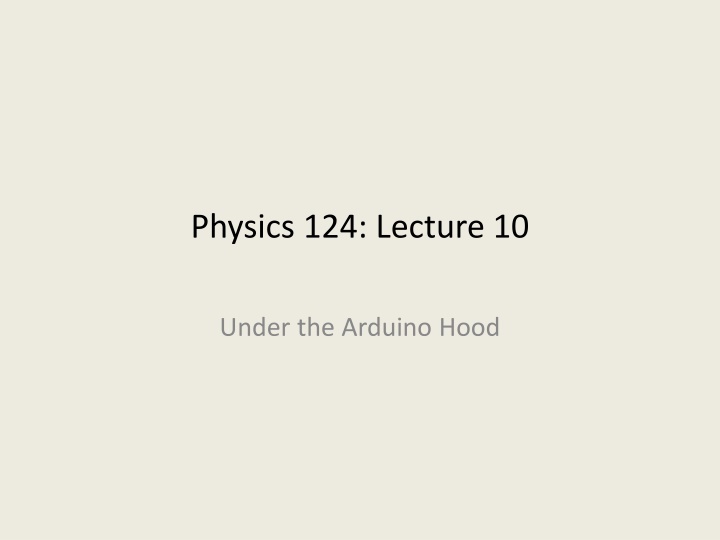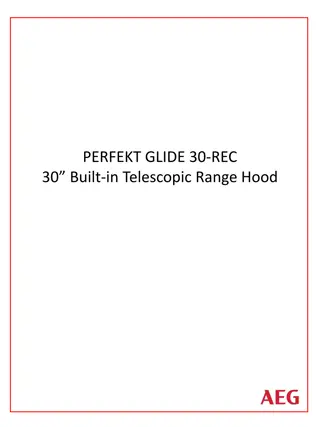
Arduino Core Directory Structure Revealed
Explore the inner workings of Arduino by delving into its core directory structure. Uncover the files and folders within the root directory, gaining insights into Arduino programming and development.
Download Presentation

Please find below an Image/Link to download the presentation.
The content on the website is provided AS IS for your information and personal use only. It may not be sold, licensed, or shared on other websites without obtaining consent from the author. If you encounter any issues during the download, it is possible that the publisher has removed the file from their server.
You are allowed to download the files provided on this website for personal or commercial use, subject to the condition that they are used lawfully. All files are the property of their respective owners.
The content on the website is provided AS IS for your information and personal use only. It may not be sold, licensed, or shared on other websites without obtaining consent from the author.
E N D
Presentation Transcript
Physics 124: Lecture 10 Under the Arduino Hood
Arduino Makes it Look Easy High-level functions remove user/programmer from processor details on the plus side, this means you can actually get things done without a steep learning curve on the down side, you don t understand fundamentally what your actions are doing or how to take advantage of processor capabilities that are not wrapped into high-level functions So today, we ll look a bit into what Arduino is actually doing to a limited extent! Phys 124: Lecture 10 2
Where Do the Monsters Lurk? What I will call the root directory is at: On a Mac: /Applications/Arduino.app/Contents/Resources/Java/hardware/ar duino/ On Windows: Arduino-Install-Directory/Hardware/Arduino/ On Linux: (likely) /usr/share/arduino/ also may check /usr/local/ I ll describe contents as found on the Mac it s what I have hopefully is reasonably universal Phys 124: Lecture 10 3
Contents of root directory On my Mac, the aforementioned directory has: boards.txt cores/ programmers.txt bootloaders/ firmwares/ variants/ boards.txt has specific info for the various Arduino boards cores/ has only a directory called arduino/, which we will investigate later bootloaders/ has atmega/ atmega8/ bt/ caterina/ lilypad/ optiboot/ stk500v2/ variants/ has eightanaloginputs/ leonardo/ mega/ standard/ each of which contains a single file: pins_arduino.h maps pinouts of specific devices Phys 124: Lecture 10 4
File Types in Standard C Programming Source Code the stuff you type in: has .c extension, or .cpp for C++ Compiled Executable the ready-to-run product: usually no extension in Unix/Mac, .exe in DOS Header Files contain definitions of useful functions, constants: .h extension Object Files a pre-linked compiled tidbit: .o in Unix, .obj in DOS only if you re building in pieces and linking later Phys 124: Lecture 10 5
In root/cores/arduino/ Here s what I show, broken out by extension I have 36 files total in this directory, all .c, .cpp, or .h First, 6 C files: mojo:arduino$ wc *.c 298 1116 8198 WInterrupts.c 324 1468 9394 wiring.c 282 1133 7374 wiring_analog.c 178 668 4931 wiring_digital.c 69 416 2643 wiring_pulse.c 55 236 1601 wiring_shift.c note: numbers apply to vers. 1.0.1: minor changes w/ time The wc function means word count returns number of lines, # of words, # of characters for each file Phys 124: Lecture 10 6
Directory, continued Now, 12 C++ files: mojo:arduino$ wc *.cpp 233 896 6718 CDC.cpp 519 1677 13772 HID.cpp 428 1442 11400 HardwareSerial.cpp 56 115 1152 IPAddress.cpp 263 798 5216 Print.cpp 270 1137 7277 Stream.cpp 601 1783 14311 Tone.cpp 672 1734 13134 USBCore.cpp 59 265 1649 WMath.cpp 645 1923 14212 WString.cpp 20 22 202 main.cpp 18 41 325 new.cpp Note in particular main.cpp: 20 lines of fun we ll look at in a bit Phys 124: Lecture 10 7
Header files Finally, the 18 header files mojo:arduino$ wc *.h 215 677 5690 Arduino.h 26 97 697 Client.h 81 289 2363 HardwareSerial.h 76 419 2978 IPAddress.h 23 42 401 Platform.h 78 328 2462 Print.h 40 207 1332 Printable.h 9 17 111 Server.h 96 584 4005 Stream.h 194 478 5224 USBAPI.h 302 846 7855 USBCore.h 63 236 1872 USBDesc.h 88 691 4180 Udp.h 167 699 4576 WCharacter.h 205 1151 8470 WString.h 515 1535 10379 binary.h 22 62 562 new.h 69 230 1752 wiring_private.h We ll look at Arduino.h next Phys 124: Lecture 10 8
Arduino.h Contains function prototypes, definition of constants, some useful algorithms Excerpts follow #include <stdlib.h> #include <string.h> #include <math.h> #include <avr/pgmspace.h> #include <avr/io.h> #include <avr/interrupt.h> #include "binary.h These are standard C libraries that are being pulled in note in particular that the math library is automatically used Phys 124: Lecture 10 9
Arduino.h, continued Now we have some constants defined recall, #define acts as text replacement #define HIGH 0x1 #define LOW 0x0 #define INPUT 0x0 #define OUTPUT 0x1 #define INPUT_PULLUP 0x2 #define true 0x1 #define false 0x0 #define PI 3.1415926535897932384626433832795 #define HALF_PI 1.5707963267948966192313216916398 #define TWO_PI 6.283185307179586476925286766559 #define DEG_TO_RAD 0.017453292519943295769236907684886 #define RAD_TO_DEG 57.295779513082320876798154814105 In some cases, to absurd precision! Phys 124: Lecture 10 10
Arduino.h, continued The #define construct can also create useful functions #define min(a,b) ((a)<(b)?(a):(b)) #define max(a,b) ((a)>(b)?(a):(b)) #define abs(x) ((x)>0?(x):-(x)) #define constrain(amt,lo,hi) ((amt)<(lo)?(lo):((amt)>(hi)?(hi):(amt))) #define round(x) ((x)>=0?(long)((x)+0.5):(long)((x)-0.5)) #define radians(deg) ((deg)*DEG_TO_RAD) #define degrees(rad) ((rad)*RAD_TO_DEG) #define sq(x) ((x)*(x)) #define lowByte(w) ((uint8_t) ((w) & 0xff)) #define highByte(w) ((uint8_t) ((w) >> 8)) #define bitRead(value, bit) (((value) >> (bit)) & 0x01) #define bitSet(value, bit) ((value) |= (1UL << (bit))) #define bitClear(value, bit) ((value) &= ~(1UL << (bit))) #define bitWrite(val, bit, bval) (bval ? bitSet(val, bit) : bitClear (val, bit)) Some labels shortened to fit on this slide (hi, lo, etc.) Phys 124: Lecture 10 11
Arduino.h, continued Also included are function prototypes so that we know what types are expected in function calls typedef uint8_t byte; // 8-bit integer, same as char void pinMode(uint8_t, uint8_t); void digitalWrite(uint8_t, uint8_t); int digitalRead(uint8_t); int analogRead(uint8_t); void analogReference(uint8_t mode); void analogWrite(uint8_t, int); unsigned long millis(void); unsigned long micros(void); void delay(unsigned long); void setup(void); void loop(void); long map(long, long, long, long, long); This is just an excerpt, for familiar functions Phys 124: Lecture 10 12
root/variants/standard/pins_arduino.h maps pins to functions excerpts: #define NUM_DIGITAL_PINS 20 #define NUM_ANALOG_INPUTS 6 #define analogInputToDigitalPin(p) ((p < 6) ? (p) + 14 : -1) // ATMEL ATMEGA8 & 168 / ARDUINO // // +-\/-+ // PC6 1| |28 PC5 (AI 5) // (D 0) PD0 2| |27 PC4 (AI 4) // (D 1) PD1 3| |26 PC3 (AI 3) // (D 2) PD2 4| |25 PC2 (AI 2) // PWM+ (D 3) PD3 5| |24 PC1 (AI 1) // (D 4) PD4 6| |23 PC0 (AI 0) // VCC 7| |22 GND // GND 8| |21 AREF // PB6 9| |20 AVCC // PB7 10| |19 PB5 (D 13) // PWM+ (D 5) PD5 11| |18 PB4 (D 12) // PWM+ (D 6) PD6 12| |17 PB3 (D 11) PWM // (D 7) PD7 13| |16 PB2 (D 10) PWM // (D 8) PB0 14| |15 PB1 (D 9) PWM // +----+ Phys 124: Lecture 10 13
root/cores/arduino/main.cpp Simple: initialize, run your setup, start infinite loop and run your loop, keeping a lookout for serial comm #include <Arduino.h> int main(void) { init(); #if defined(USBCON) USBDevice.attach(); #endif setup(); for (;;) { loop(); if (serialEventRun) serialEventRun(); } return 0; } Phys 124: Lecture 10 14
Finally, root/boards.txt Examples for Uno and Nano uno.name=Arduino Uno uno.upload.protocol=arduino uno.upload.maximum_size=32256 uno.upload.speed=115200 uno.bootloader.low_fuses=0xff uno.bootloader.high_fuses=0xde uno.bootloader.extended_fuses=0x05 uno.bootloader.path=optiboot uno.bootloader.file= optiboot_atmega328.hex uno.bootloader.unlock_bits=0x3F uno.bootloader.lock_bits=0x0F uno.build.mcu=atmega328p uno.build.f_cpu=16000000L uno.build.core=arduino uno.build.variant=standard nano328.name=Arduino Nano w/ ATmega328 nano328.upload.protocol=arduino nano328.upload.maximum_size=30720 nano328.upload.speed=57600 nano328.bootloader.low_fuses=0xFF nano328.bootloader.high_fuses=0xDA nano328.bootloader.extended_fuses=0x05 nano328.bootloader.path=atmega nano328.bootloader.file= ATmegaBOOT_168_atmega328.hex nano328.bootloader.unlock_bits=0x3F nano328.bootloader.lock_bits=0x0F nano328.build.mcu=atmega328p nano328.build.f_cpu=16000000L nano328.build.core=arduino nano328.build.variant=eightanaloginputs Note core, variant and CPU speed 16 MHz Phys 124: Lecture 10 15
But the Rabbit Hole Goes Much Farther Underneath it all is a microprocessor with staggering complexity full datasheet (avail via course website) is 567 pages summary datasheet (strongly encourage perusal) is 35 pp. Note in particular in the summary datasheet: p. 2 the Uno uses the 28-pin PDIP (upper right) read the port descriptions on pp. 3 4, even if foreign block diagram p. 5 register map pp. 7 12 assembly instruction set pp. 13 15 can safely ignore pp. 16 35 ;-) Phys 124: Lecture 10 16
Assignments/Announcements Absorb as much as possible from the summary datasheet Project proposals due end of week (2/5) recommend pre-discuss with prof/TA, if haven t already Lab 4 due by 2PM on Feb 9/10 dep. on section Midterm next week (Wed, Feb 10) Phys 124: Lecture 10 18






















